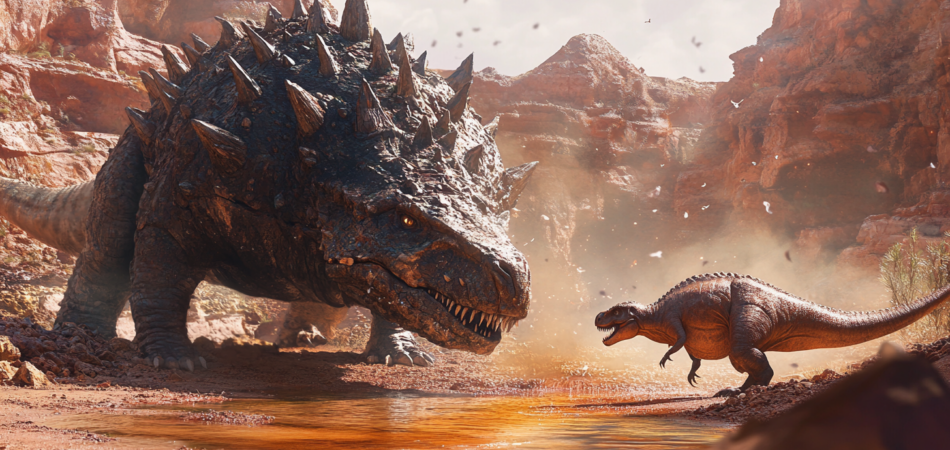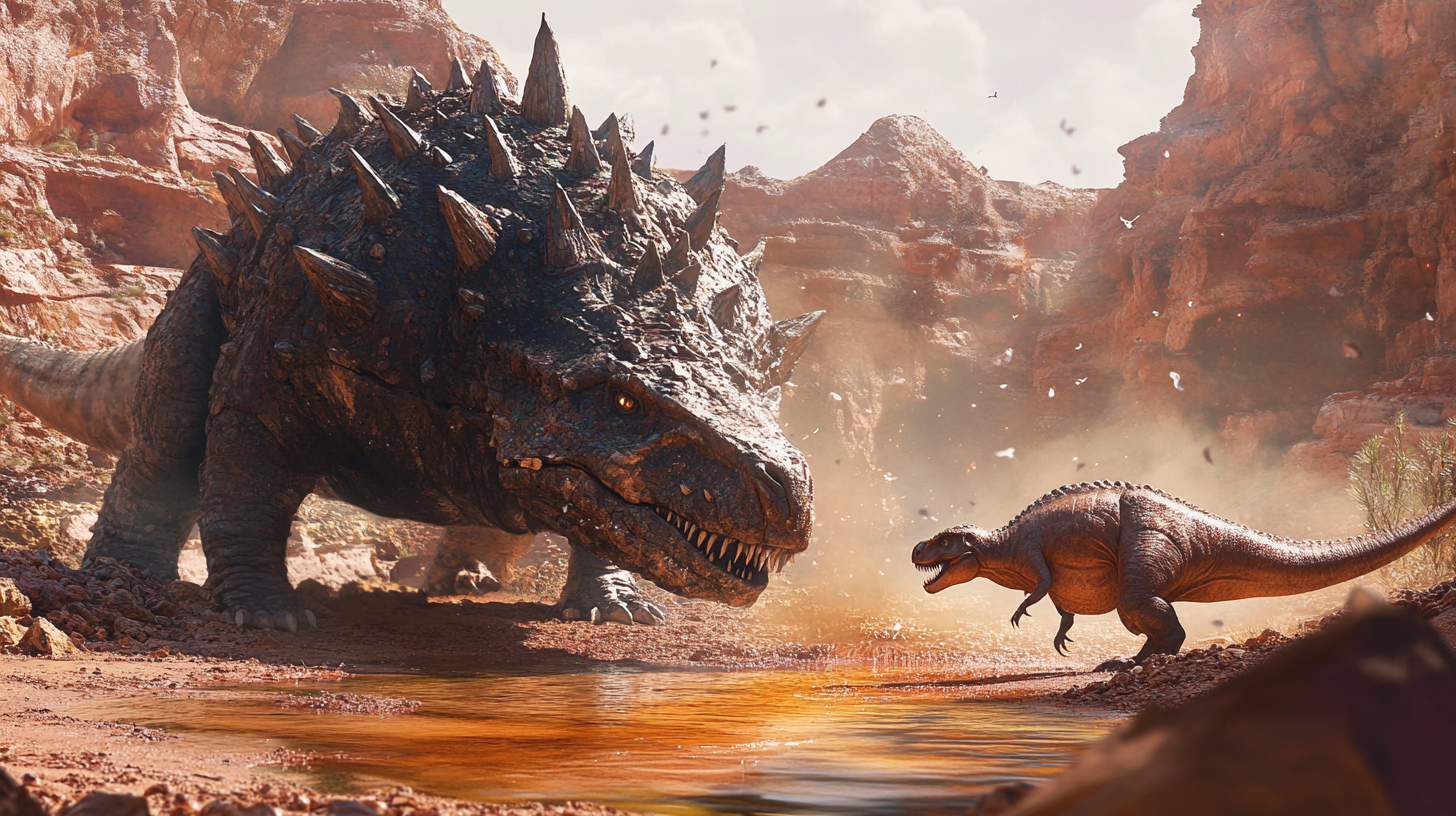Aardonyx Guide:
Aardonyx was an early dinosaur that lived in South Africa about 200 million years ago.
Aardonyx was an early dinosaur that lived in South Africa about 200 million years ago.

You might think that only the colossal dinosaurs left their mark on prehistoric Earth, but the truth is far more intriguing. Consider the world of small but significant dinosaurs like Compsognathus and Microraptor. These creatures, despite their size, had clever adaptations that allowed them to not only survive but also to shape their ecosystems in remarkable ways. How did these tiny titans influence their environments and contribute to ecological balance? As you explore the fascinating roles these diminutive giants played, you'll uncover surprising insights into evolution and the lasting legacy of these ancient beings.

When examining the fossil record, it's vital to recognize that small dinosaurs played a significant role in their ecosystems, often overshadowed by their larger counterparts. These diminutive creatures exhibited distinct small dinosaur characteristics, such as lightweight skeletons and agile builds, which facilitated their survival and adaptation.
Fossil discoveries have revealed their ecological roles, showcasing that they were essential in maintaining the balance within their habitats. By preying on insects, small vertebrates, and scavenging, they contributed to controlling population dynamics and nutrient cycling.
Their evolutionary advantages can't be ignored. Small dinosaurs often possessed predatory strategies that allowed them to exploit niches inaccessible to larger predators. Their speed and agility enabled them to hunt efficiently and avoid becoming prey themselves.
Some species developed specialized feeding mechanisms, such as sharp teeth or beaks, adapted to their specific diets. Additionally, fossil evidence suggests that their size allowed for increased reproductive rates, which furthered their evolutionary success.
This rapid reproduction may have provided a buffer against extinction events, ensuring their lineage persisted across different geological periods. Understanding these aspects highlights the importance of small dinosaurs in the broader narrative of prehistoric life, underscoring their indispensable contributions to ancient ecosystems.
When you examine key small dinosaur species like Compsognathus, Microraptor, Hypsilophodon, and Parvicursor, you'll find each contributed uniquely to our understanding of dinosaur evolution and ecology.
Compsognathus, often considered a model of theropod anatomy, revealed insights into predator-prey interactions, while Microraptor's four-winged morphology provided evidence for the evolutionary link between dinosaurs and birds.
Hypsilophodon and Parvicursor, with their specialized adaptations, highlighted the diversity of ecological niches that small dinosaurs occupied, offering a broader perspective on Mesozoic ecosystems.
Compsognathus, a small yet significant theropod dinosaur, has captivated paleontologists with its well-preserved fossils that provide valuable insights into Jurassic ecosystems. These fossils, primarily discovered in Europe, suggest that Compsognathus thrived in a habitat characterized by lush, subtropical environments with ample access to water sources.
Such conditions likely supported a diverse array of prey, aligning with evidence that indicates a carnivorous diet primarily consisting of small vertebrates and insects.
Compsognathus fossils reveal a lightweight, agile body structure that facilitated swift locomotion, a critical adaptation for both hunting and evading larger predators. Analysis of hind limb proportions and foot morphology suggests that Compsognathus was a bipedal runner, capable of rapid acceleration and sustained pursuits.
This locomotor capability would have been essential for its predation strategy, allowing it to ambush or chase down prey with precision and speed.
The study of Compsognathus fossils has furthered our understanding of niche specialization among small theropods, underscoring its role as an efficient predator within its ecological community.
Among the remarkable small dinosaur species, Microraptor stands out for its intriguing blend of avian and non-avian features. This genus, primarily known from Early Cretaceous fossils discovered in Liaoning, China, provides valuable insights into the evolution of flight.
Microraptor's feathers are a key focal point, exhibiting an advanced structure that suggests it possessed the capability for gliding. The asymmetric vanes of its feathers, particularly those on its forelimbs and hindlimbs, support the hypothesis of a form of Microraptor flight, though not powered like modern birds.
Examining the Microraptor fossils reveals:
This multifaceted dinosaur presents a compelling case of evolutionary innovation, bridging the gap between terrestrial dinosaurs and avian species.
The Microraptor's unique adaptations underscore its significance in understanding the complexities of dinosaur flight evolution and ecological niches during the Cretaceous period.
Hypsilophodon, often overshadowed by its larger contemporaries, offers fascinating insights into the adaptability and evolutionary strategies of small herbivorous dinosaurs. As a species that thrived during the Early Cretaceous period, Hypsilophodon inhabited forested environments, suggesting a habitat rich in vegetation.
This small dinosaur's diet consisted primarily of ferns and cycads, as indicated by tooth morphology and wear patterns found in Hypsilophodon fossils. Such dietary preferences allowed it to exploit niches relatively untapped by larger herbivores, providing a competitive advantage.
In terms of locomotion, Hypsilophodon exhibited bipedal movement, characterized by strong hind limbs and a lightweight body, enabling it to reach speeds that likely helped in evading predators. The presence of large eye sockets in the skull suggests acute vision, further aiding in predator detection and survival.
Fossil evidence from the Isle of Wight has given researchers a clearer picture of Hypsilophodon's anatomy, underscoring its adaptability and resilience.
Despite facing threats from contemporaneous predators, Hypsilophodon's evolutionary success was marked by its ability to utilize its environment efficiently, showcasing the significant role small dinosaurs played in prehistoric ecosystems.
Parvicursor, a small yet remarkable theropod dinosaur, exemplifies the diversity and specialization of small dinosaur species during the Late Cretaceous period. This tiny dinosaur, with an estimated length of just 39 cm, thrived in the arid habitats of what's now Mongolia. Its habitat preferences likely included open, sandy environments where its unique adaptations could be fully utilized.
Parvicursor's dietary habits suggest an insectivorous diet, as evidenced by its slender, elongated fingers, ideal for probing into crevices to extract insects and other small invertebrates.
Parvicursor's locomotion abilities were particularly advanced, characterized by long, slender legs that indicate a bipedal, cursorial lifestyle. This adaptation would have enabled rapid movement, vital for both evading predators and pursuing prey.
The fossil discoveries of Parvicursor, primarily from the Djadokhta Formation, have provided significant insights into the evolutionary significance of small theropods.

When considering the behavior and adaptations of small dinosaurs, one finds a fascinating array of strategies that these creatures employed to survive in diverse prehistoric environments. Their social behavior often included forming groups, providing increased vigilance and protection against predators. Evidence suggests that some species, like the Psittacosaurus, might've exhibited herd behavior, allowing them to coordinate movements and reduce individual risk.
Small dinosaurs demonstrated varied feeding strategies, often dictated by their specific ecological niches. For example, the small, bipedal Compsognathus likely exploited insect-rich areas, using its agility to capture prey. This ties into their advanced locomotion techniques; many small dinosaurs, such as the agile Velociraptor, possessed strong hind limbs and lightweight frames, enabling rapid bursts of speed essential for both hunting and predator avoidance.
Reproductive adaptations were vital for these dinosaurs' survival. Some species may have developed nesting behaviors similar to modern birds, ensuring offspring survival through protection and incubation.
Predator avoidance involved not only speed but also camouflage and possibly nocturnal lifestyles, allowing them to exploit different temporal niches. These adaptations highlight the evolutionary ingenuity of small dinosaurs in responding to ecological challenges.
Small dinosaurs' remarkable behaviors and adaptations weren't just survival strategies but key elements influencing their evolutionary pathways.
You can observe how their small size granted them significant evolutionary advantages. Small dinosaurs could exploit ecological niches that were inaccessible to their larger counterparts. They maneuvered through dense vegetation and hid from predators with ease, a demonstration of their adaptability in the face of predator dynamics.
Fossil discoveries have revealed fascinating insights into these creatures. By examining size comparisons, you can see how smaller dinosaurs often evolved unique features to thrive.
Consider how their lightweight bodies allowed for increased agility, essential for traversing complex environments. These adaptations aren't only observed in fossil records but also serve as critical evidence of their evolutionary success.

The study of small dinosaurs provides modern science with invaluable insights into evolutionary biology and adaptive strategies. Fossil discoveries of these diminutive species enable you to comprehend their ecological roles within prehistoric ecosystems, illustrating their contributions to biodiversity and resource distribution.
By examining these fossils, you can better understand how small dinosaurs adapted to their environments, potentially offering clues about the evolutionary pressures they faced. Anatomical studies of these creatures reveal sophisticated structural adaptations that allowed them to thrive.
For instance, analyzing the lightweight skeletal frameworks of certain small dinosaurs shows how they achieved remarkable agility and speed, traits that might've been vital for survival. Such findings help refine existing evolutionary theories, challenging assumptions about the correlation between size and evolutionary success.
Furthermore, paleontological methods employed in the excavation and analysis of small dinosaur fossils have progressed considerably. These techniques allow you to reconstruct not only the physical appearance of these species but also their possible behaviors and interactions within their habitats.
As you explore these studies, the impact on modern science becomes evident, as they enhance our understanding of evolutionary mechanisms and adaptive responses across different geological periods.
In understanding tiny dinosaurs, you appreciate their essential ecological roles. These small species, like Compsognathus and Microraptor, show how size doesn't dictate impact. Adaptations such as agility and specialized diets allowed them to exploit niches, controlling prey populations and contributing to nutrient cycling. Their evolutionary significance is clear, as they reshaped ecosystems and provided insights into biodiversity's complexity. Today, they inspire modern scientific exploration, emphasizing that even the smallest species can have profound effects on their environments.